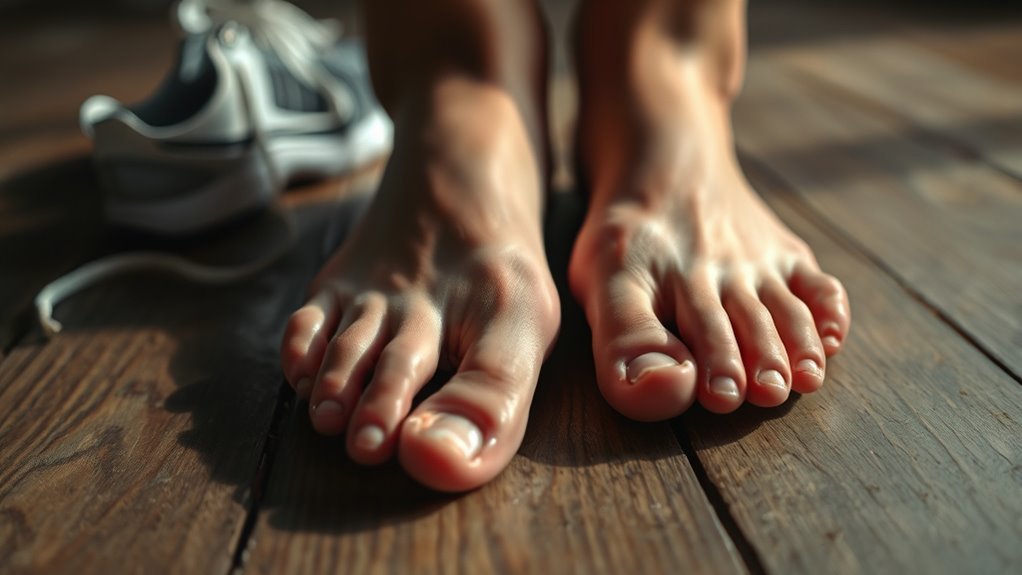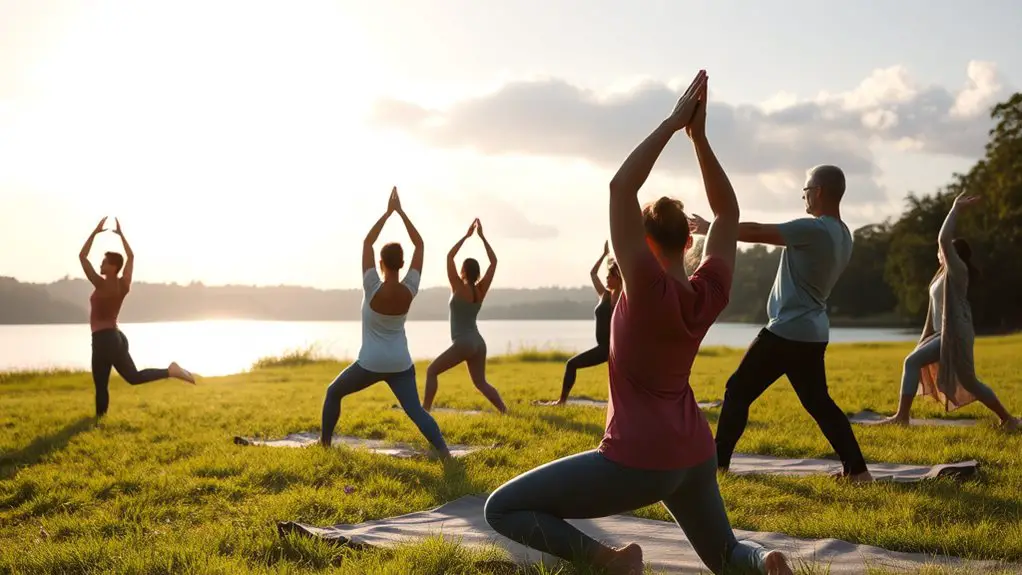Athlete’s foot can be quite painful. You might experience intense itching, burning sensations, and skin irritation, which can disrupt your daily activities. The pain often stems from inflammation and skin breakdown, making simple movements uncomfortable. If left untreated, the discomfort can escalate and lead to further complications. Finding effective treatments and preventive measures is key to managing this condition. There’s more to learn about how to keep your feet healthy and pain-free.
Understanding Athlete’s Foot: Causes and Symptoms
Although it’s often dismissed as just a minor annoyance, athlete’s foot can lead to significant discomfort if left untreated. This common fungal infection thrives in warm, damp environments, like locker rooms and sweaty shoes. You might notice symptoms like itching, burning, or peeling skin between your toes. To regain your freedom from this irritation, focus on infection prevention by keeping your feet clean and dry. Choose breathable footwear and change socks regularly to minimize moisture. If you do find yourself battling athlete’s foot, effective fungal treatments are available over-the-counter, but don’t hesitate to consult a healthcare professional if symptoms persist. Taking these steps can help you kick that pesky infection to the curb and enjoy life without the distraction of discomfort.
The Connection Between Athlete’s Foot and Pain
If you’re dealing with athlete’s foot, you might be surprised to find that it can lead to pain in your feet. The symptoms you experience, along with the underlying causes of your discomfort, can greatly affect your daily life. Fortunately, there are various treatment options available to help alleviate both the infection and the pain it causes.
Symptoms of Athlete’s Foot
What symptoms should you be on the lookout for when dealing with athlete’s foot? You might notice itchy feet, which can drive you crazy. This fungal infection often starts between your toes, where it’s warm and damp. Red, scaly patches may appear on your skin, and blisters could form, making it uncomfortable to walk. You might also experience peeling or cracking skin, which can worsen if left untreated. Sometimes, the infection can even spread to your nails, causing them to become discolored or thick. If you’re feeling any of these symptoms, don’t ignore them. Taking care of your feet is essential for your freedom to move and enjoy life without discomfort.
Causes of Foot Pain
Ignoring the symptoms of athlete’s foot can lead to more than just discomfort; it can also result in significant foot pain. When the fungus takes hold, it can irritate the skin, causing inflammation that disrupts your foot anatomy. The resulting swelling and redness can act as pain triggers. You might find that simple activities, like walking or standing, become increasingly uncomfortable. The pain often stems from the skin’s breakdown, which can expose the underlying tissues to further irritation. If neglected, this condition can escalate, leading to more severe complications and lasting discomfort. Understanding the connection between athlete’s foot and foot pain empowers you to take action and reclaim your freedom to move without hindrance.
Treatment Options Available
While athlete’s foot can lead to significant discomfort, effective treatment options are available to alleviate both the infection and the associated pain. Start by maintaining good foot hygiene; keeping your feet clean and dry can prevent the fungus from thriving. Over-the-counter antifungal medications, like creams and powders, can effectively combat the infection and reduce pain. If symptoms persist, consult your doctor for prescription options. Remember to change your socks regularly and choose breathable footwear to promote air circulation. You might also consider home remedies, such as soaking your feet in vinegar or using tea tree oil. By addressing both the infection and your foot hygiene, you can regain your comfort and freedom to move without pain.
Different Types of Athlete’s Foot and Their Impact
When it comes to athlete’s foot, not all types are created equal. You might experience different symptoms, ranging from mild itching to severe discomfort, depending on the type of infection. Understanding these variations can help you gauge how serious your condition might be.
Common Symptoms Experienced
Athlete’s foot, a common fungal infection, manifests in several ways, each type bringing its own set of symptoms. You might experience itchy sensations, which can range from mild to intense, depending on the type. In some cases, the skin may become red and flaky, while blisters can form, causing discomfort. If you notice peeling between your toes or on the soles of your feet, that’s another sign to watch for. Symptom recognition is essential; catching it early can help prevent further irritation. You don’t have to feel trapped by the discomfort. Understanding these symptoms empowers you to take action, reclaim your freedom, and find relief from athlete’s foot. Keep your feet dry and clean to minimize the risk of flare-ups.
Severity of Infections
Understanding the severity of athlete’s foot is essential, as different types of infections can lead to varying levels of discomfort and complications. There are three main types: interdigital, moccasin, and vesicular. Interdigital athlete’s foot usually causes mild pain intensity between your toes, while moccasin can result in skin cracking and deeper discomfort. Vesicular athlete’s foot often presents with blisters, which can be quite painful and may lead to secondary infections if not treated promptly. You might find that infection severity can directly impact your daily activities, limiting your freedom to move comfortably. Addressing the type of infection and its symptoms early on can help alleviate pain and prevent complications, allowing you to enjoy life without the burden of discomfort.
Managing Discomfort: Home Remedies and Treatments
Dealing with the discomfort of athlete’s foot can be frustrating, but several home remedies and treatments can help ease your symptoms. You don’t have to suffer; embrace these natural remedies and topical treatments to find relief:
- Tea Tree Oil: Known for its antifungal properties, apply diluted tea tree oil directly to the affected area.
- Garlic Paste: Crush garlic cloves and mix with a little olive oil to create a paste. Apply this to the infection for potent relief.
- Apple Cider Vinegar Soak: Combine equal parts water and apple cider vinegar in a basin, and soak your feet for 20 minutes to help soothe irritation.
These methods can help you regain comfort and freedom from athlete’s foot, allowing you to enjoy life without the nagging itch.
When to Seek Medical Attention
When should you consider seeking medical attention for athlete’s foot? If you notice signs of worsening, like increased redness, swelling, or drainage, it’s time to consult a healthcare professional. Persistent pain or discomfort that doesn’t improve with over-the-counter treatments is another red flag. If your symptoms start spreading to other parts of your body or you develop a fever, don’t wait too long. Remember, freedom from discomfort is essential for your well-being. By addressing these signs early, you can prevent more serious complications and get back to enjoying life. Trust your instincts; if something feels off, it’s better to seek help than to suffer in silence. Take charge of your health and don’t hesitate to reach out.
Preventing Athlete’s Foot and Associated Pain
To prevent athlete’s foot and the pain it can cause, you should focus on maintaining proper foot hygiene and making smart choices about footwear. Here are some key hygiene practices to keep in mind:
- Wash your feet daily: Use soap and water, ensuring you dry them thoroughly, especially between your toes.
- Choose proper footwear: Opt for breathable shoes made from materials like leather or canvas, and avoid tight-fitting options that trap moisture.
- Use antifungal powder: Sprinkle some in your shoes and on your feet to keep them dry and reduce the risk of infection.
Frequently Asked Questions
Can Athlete’s Foot Spread to Other Body Parts?
Yes, athlete’s foot can spread to other body parts, especially if you don’t take proper care. It often starts between your toes but might move to your hands or nails. For effective symptom identification, keep an eye out for redness and itching. Treatment options include antifungal creams or powders. To maintain your freedom from this pesky condition, make sure to practice good hygiene and avoid sharing personal items like towels or shoes.
Is Athlete’s Foot Contagious to Others?
Yes, athlete’s foot is contagious. Imagine you’re at a gym, and you borrow a friend’s flip-flops. If they have athlete’s foot, you might end up with it too! Transmission methods include direct contact with infected skin or surfaces like showers and locker rooms. To avoid this, practice prevention strategies like wearing sandals in communal areas and keeping your feet dry. Staying aware can help you enjoy your freedom without the worry of infections.
How Long Does Athlete’s Foot Typically Last?
Athlete’s foot typically lasts from a couple of weeks to a few months, depending on various duration factors like the severity of the infection and how quickly you start treatment. To speed up your recovery, keep your feet clean and dry, use antifungal creams, and avoid sharing personal items. By taking these recovery tips seriously, you can regain your freedom from discomfort and enjoy your activities without the nagging itch of athlete’s foot.
Are Certain Footwear Types More Prone to Athlete’s Foot?
Yes, certain footwear types can definitely contribute to athlete’s foot. Imagine slipping into those snug, synthetic shoes that hug your feet but leave no room for airflow—it’s a breeding ground for fungi. Poor foot health can stem from materials that trap moisture, like rubber and plastic. Opt for breathable fabrics like cotton or mesh; they help your feet stay dry and free. After all, you deserve the freedom to roam without worry!
Can Athlete’s Foot Recur After Treatment?
Yes, athlete’s foot can definitely recur after treatment. Recurrence factors include inadequate treatment, wearing damp shoes, or not maintaining proper foot hygiene. To minimize the chances of it coming back, you should explore effective treatment options like antifungal creams or powders. Remember to keep your feet dry and choose breathable footwear. By staying proactive and vigilant, you can enjoy your freedom without the hassle of dealing with athlete’s foot again!




